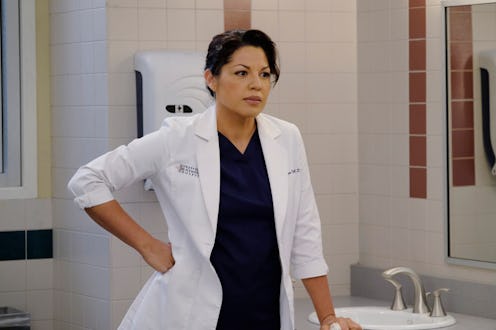
After 10 years as Dr. Callie Torres, Sara Ramirez departed Grey's Anatomy at the end of Season 12. And that's particularly upsetting, because Callie will always be a beacon for representation. Right from the start, Callie was a body confident Latina character who did not look like anyone else in the world of Grey's Anatomy, which was filled with mostly conventionally attractive Hollywood body types, and, as her journey continued, Callie only became more important when she came out as bisexual. In the world of television, a character of color who identifies as bisexual and is also a badass surgeon with a complicated work and romantic life was impossible to find elsewhere on network television.
Callie is a character who an incredible amount of fans across cultures and experiences could identify with. As a full-bodied woman myself, I will never forget seeing Callie for the first time as she danced around in her underwear, uninhibited and carefree. The scene felt revolutionary in an era where body confidence was rarely, if ever, talked about in a meaningful way. That was just the beginning of Callie's importance as a character whose presence on the television landscape challenged the status quo.
Grey's Anatomy has been a diverse show right from the start, putting characters of color front and center, and giving them amazing storylines that delved into their careers, romances, and family lives. Callie was the first series regular Hispanic character the series introduced, and, while there are roughly 55 million Hispanic people in the United States according to the 2014 United States Census, when Callie first appeared on Grey's Anatomy in 2005, there were precious few major Hispanic characters on network TV outside of ABC's long-running series Ugly Betty.
While Callie increased that visibility as a Latina character, she was never treated as a token character by the series. She was brilliant, assertive, confident, and sometimes rash and stubborn. She was so beautifully human that it was impossible not to love her. The idea that she could become an even more important character to the series was hard to imagine until she began a relationship with Dr. Erica Hahn.
Prior to the introduction of Erica, the one area of representation Grey's Anatomy had spent little time focusing on was sexual identity. The major characters of Grey's were straight with not one major LGBTQ character on the show until Erica and Callie began a relationship together. While Callie had exclusively been in relationships with men in the past, her relationship with Erica opened the door for her to explore her sexual identity in a meaningful way, and fans took notice.
Starting in Season 4 and continuing straight through Season 12 when Callie departed Grey Sloan Memorial Hospital to be with her new girlfriend Penny in New York, Callie became network TV's most prominent bisexual character. True bisexual characters are a rarity in the world of television, but Callie represented the LGBTQ community as a woman who had meaningful relationships with both men and women.
Callie's relationship with fellow doctor Arizona became one of the show's most beloved, with fans dubbing the duo "Calzona." Grey's took extra care to have Callie truly go on a journey. She took time to figure out who she was, and, initially, the out and proud Arizona was uncertain about becoming involved with Callie because she was just beginning to identify as bisexual when they met. The two ultimately became a supercouple who received accolades from fans and sites like AfterEllen.com.
What was truly revolutionary about Callie is that she was never defined by any single aspect of herself. She was curvy, Latina, and bisexual, and she was also a funny, frustrating, and lovable doctor with an amazing career and strong friendships. Callie was never expected to be perfect. She was allowed to be as messy as every other character on Grey's Anatomy, and, for everyone who identified with her as a whole or in part, it was a huge relief to see this woman who represented so many perspectives be allowed to just be awesome.
Now, Latina and LGBTQ characters are more prevalent on TV in 2016 than they were in 2005, but that only makes Callie all the more important. She made Grey's Anatomy a better show, and her influence on the small screen is one that will never be forgotten by the fans whose lives she touched.
Images: Tony Rivetti/ABC; Giphy (3)